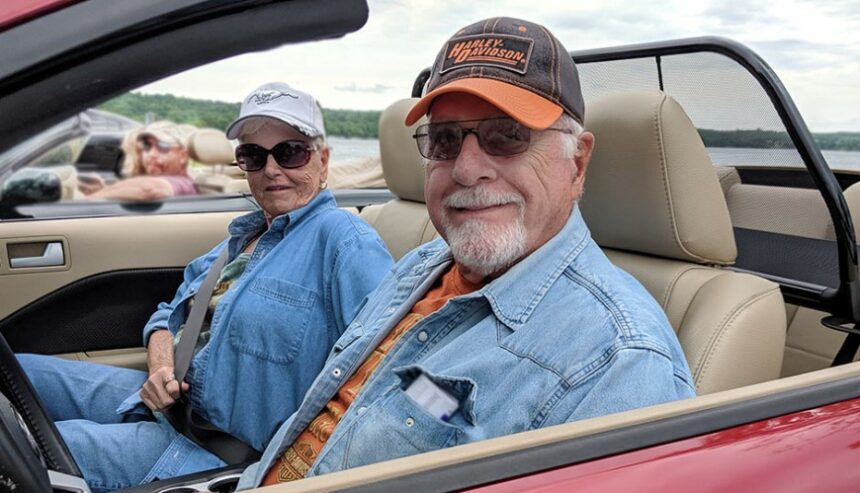Ray could crush walnuts with his hand. As a retired carpenter and maintenance man, he still enjoys working with his hands – from carpentry and fixing motorcycles in his shop to bowling, playing beanbags, and riding motorcycles – he is active. Seven months ago that all changed – but there is a shiny, happy ending.
In the sun and warmth of Arizona, Ray and his wife escape the five-month winters of Minnesota. Shortly upon settling in and starting their active retirement life this past winter, Ray felt a clicking sensation in his hand and heard a “pop” when he opened it. “One morning, I woke and my hand was in a fist. I could not open it without using my other hand,” he said. Ray rapidly lost most of the use and strength in his right-hand within a week. His fingers were stuck in a bent position, losing the ability to do what he enjoyed. Ray said, “I had to force my hand open to grip the bowling ball and I dropped it. I did not even have the strength to hold it.” Thinking of motorcycling, and how important his right hand is for throttling, he was concerned he would lose one of his biggest joys.
The Urgent Care in Yuma, AZ was not able to do anything because it is a condition in the tendons and recommended he see an orthopedic doctor. Ray wanted to put off having surgery until they returned so they finished the southern winter, and called Glenwood Medical Center on their way back. Dr. Rod Brown readily identified it as trigger finger, a condition caused by narrowing of the tunnel, or tendon sheath, for one or more flexor tendons. These tendons extend from your forearm to the muscles and bones in your hands so when the tunnels narrow, the tendons do not glide as easily.
A few weeks later, Ray saw an orthopedic surgeon at Glacial Ridge Hospital. “He was kind and confident that he could easily fix it,” said Ray. “He clearly explained the outpatient surgical procedure for trigger finger.”
The procedure is called “tenolysis” or “trigger finger release.” The recovery time for trigger finger surgery is quick and the procedure has a high chance of success. As a general rule, once the doctor releases the tightened tendon sheath and cleans up the tendons, the tendon can move freely which was the case for Ray.
 The surgeon made three small incisions in Ray’s palm to fix the condition, and Ray said he left the OR a few hours later. “I had no pain whatsoever after that. The only discomfort was removing the stitches several days later,” Ray said with a smile. “I have full use of my right hand and fingers after months of nothing. I can pick things up and put things in my pocket,” he added gratefully.
The surgeon made three small incisions in Ray’s palm to fix the condition, and Ray said he left the OR a few hours later. “I had no pain whatsoever after that. The only discomfort was removing the stitches several days later,” Ray said with a smile. “I have full use of my right hand and fingers after months of nothing. I can pick things up and put things in my pocket,” he added gratefully.
While he could flex and make a fist right afterward, Ray has some work to do to regain his hand and arm strength. The inability to use his hand for five months had caused Ray’s forearm muscles to atrophy so his right arm was a third of the size of the left. Determined to regain muscle strength as quickly as he safely could, he uses his hand and exercises it as often as possible – both at home, in his shop, and on the go.
Ray was able to return to his normal activities within a few days. 11 days after surgery, Ray attended the annual Glacial Ridge Hospice Motorcycle Ride and Car Run. He wanted to get back on the motorcycle, especially for this ride but knew his hand would tire too easily. This year, he and his wife cruised in four wheels but is happily back on his bike now.
Ray is an experienced orthopedic patient – he has had both knees and an ankle replaced, plus surgery to repair a detached bicep. Comparing past experiences at other hospitals to his medical and surgical experiences at Glacial Ridge, Ray knows just how different the atmosphere and care can be.
“I hope people in Pope County appreciate what they have here. At Glacial Ridge, everyone cares and makes you feel good about being there. You never feel like you are an inconvenience to them. Everyone is super nice. From the reception and clinic staff to operating room nurses and surgeon, they are 100% good people and take care of you.”
Learn more about Orthopedic Services and our resources including:
- Orthopedic Symptom Checker
- 3 Tips for When to See an Orthopedic Specialist
- Why See an Orthopedic Surgeon?


